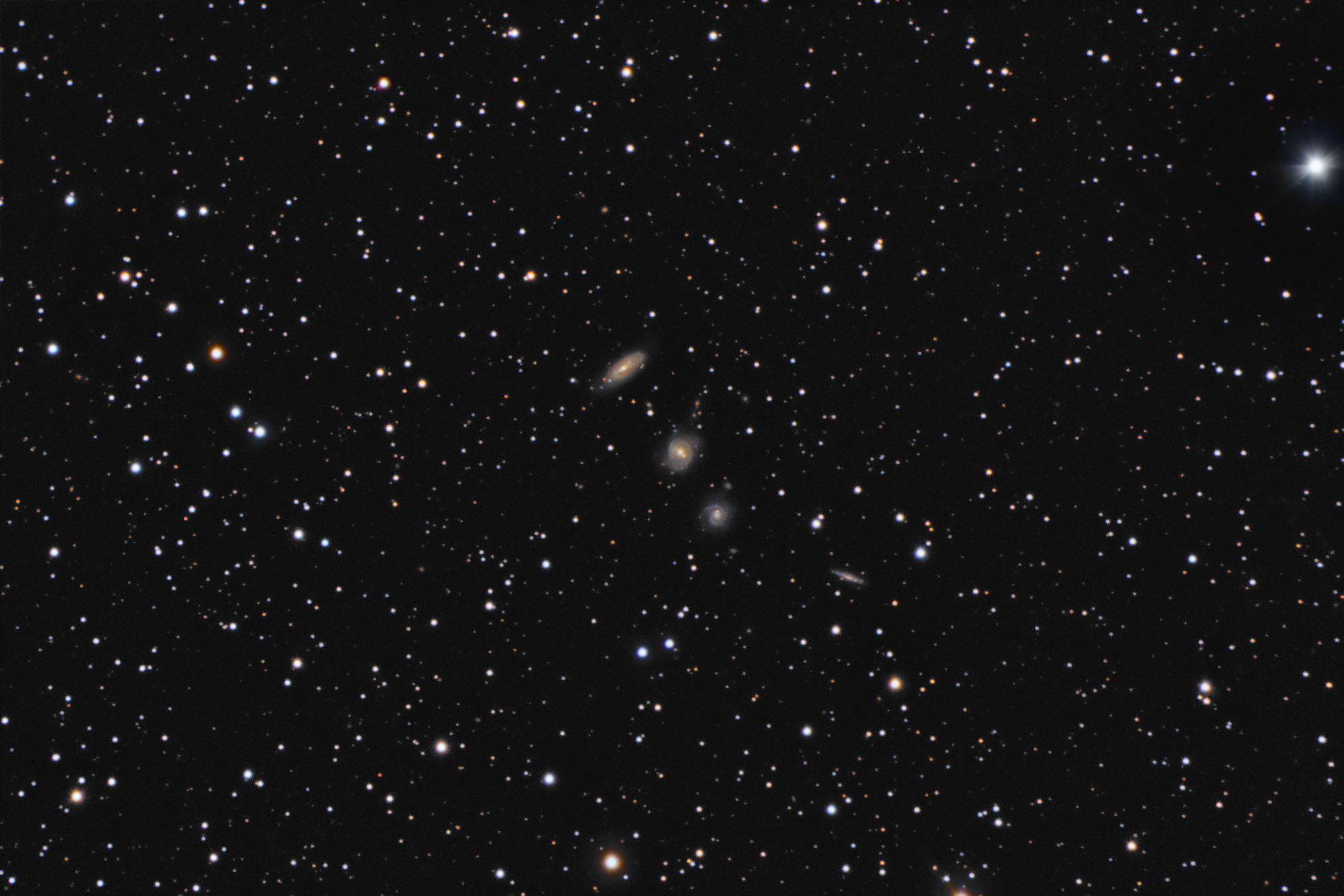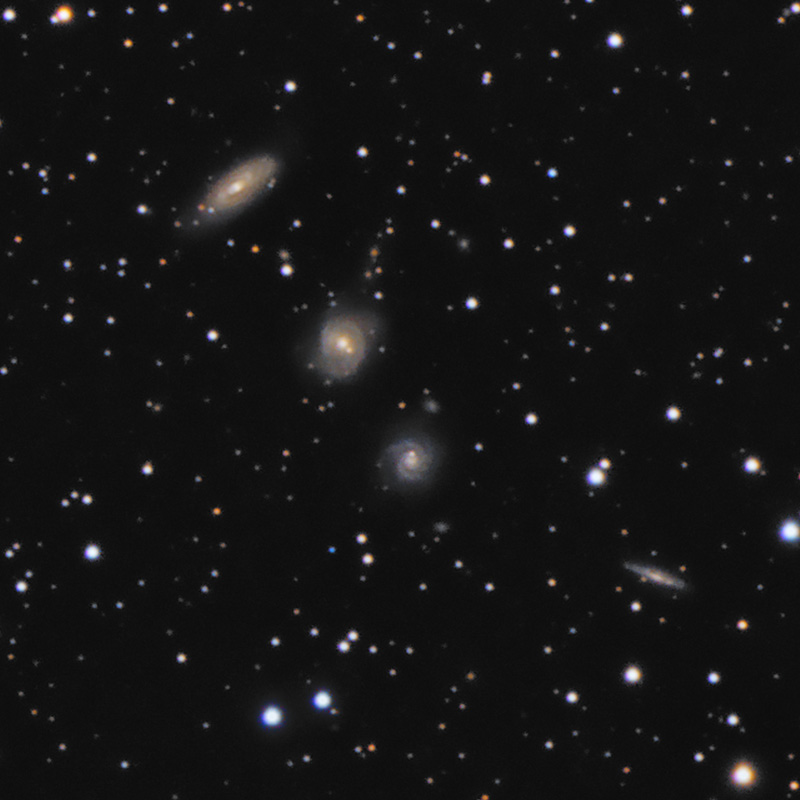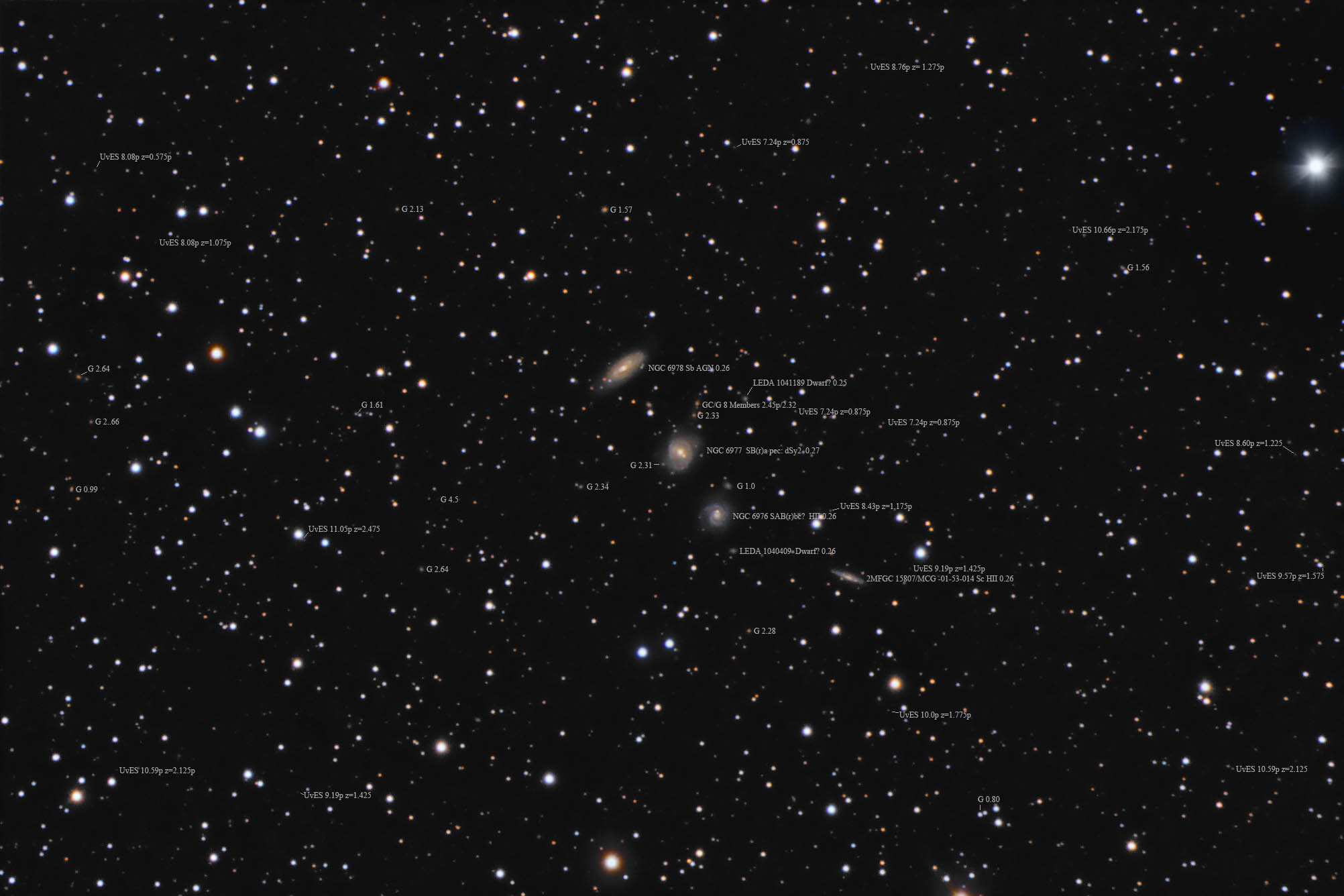Object name: NGC6976Designation(s): NGC6976, NGC6977, NGC6978, Hickson 88 consists of only 4 galaxies at a distance of about 260 million light-years. All four are spirals with three nearly face on. All are of unusually low contrast making details rather indistinct. It didn't help that there was a weak aurora this night and even though it the field is low in the southern sky it was still a 6 times brighter sky than I normally have. From left to right (top to bottom) they are NGC 6978, NGC 6977, NGC 6976 and 2MFGC 15807. The latter being a flat galaxy per the 2 micron survey rules. That gave me two reasons to image this group, its a Hickson Compact Group and there's a flat galaxy in the image. This group is in northwestern Aquarius.
NGC 6976 is classed as SAB(r)bc? with HII emission by NED while the NGC Project says Sbc in its simpler system. It has a dual entry in the NGC catalog also listed as NGC 6975. It was "discovered" twice. First by Albert Marth in 1864 then by Guillaume Bigourdan in 1886 who later realized he made a positional error and was off by 180 degrees. Both "findings" made it into the NGC catalog. I used the 6976 name since it came first. It is also HCG 88C using Hickson's numbering scheme.
NGC 6977 is classed as SB(r)a pec: dSy2 by NED and simply SBb by the NGC project. They don't quite agree. It was found also by Albert Marth but in 1863. How he missed 6976 at that time I don't know. It is HCG 88B by Hickson's labeling.
NGC 6978 is classed as Sb AGN by the NED and Sb without mention of the AGN by the NGC Project. Like 6977 it was discovered by Albert Marth in 1863 and is HCG 88A
The fourth member of HCG 88 is HCG 88D or more commonly MCG -01-53-14 and is classed simply as S? by NED. It's the only one of the 4 that doesn't seem disturbed. The three NGC galaxies all show signs of being stirred up by interaction with each other.
The field has set a record for me for quasar candidates with 16 of them in the field and several more just outside it. None, however, have been confirmed spectroscopically, at least as far as I can tell from their NED listings. All are based on photographic red-shift measurements. In a few cases, the Sloan survey says they are only stars. Arp always considered quasars as nearby objects with their redshift being due to other factors than distance. He considered them as being emitted by active galaxies. He loved to point out active galaxies with lots of quasars (4 or 5 was "a lot") as proof of his ideas. He tended to ignore active galaxies without them saying they just hadn't emitted them yet. Everyone else sees this as just random distribution. I wonder if he knew of this field? Seems to be just what he'd want. Three active galaxies with 5+ quasars apiece. Now that he is gone maybe his idea will finally fade away as well. It might have seemed somewhat plausible 40+ years ago but not today. A couple of the quasar candidates are so close to other stars you will need to double or triple the size of the image (unless your monitor has unusually large pixels) to separate them from the star. A line has been drawn to the quasar candidate in these cases. UvES stands for Ultraviolet Excess Source for those new to my annotations. Such objects, when starlike usually prove to be quasars.
14" LX200R @ f/10, L=4x10' RGB=2x10', STL-11000XM, Paramount ME Related Designation(s):2MASS J20522600-0546202, 2MASS J20522969-0544458, 2MASS J20523544-0542399, 2MASX J20522602-0546198, 2MASX J20522971-0544459, 2MASX J20523547-0542399, 2MASXi J2052260-054615, 2MASXi J2052260-054620, 2MASXi J2052297-054446, 2MASXi J2052354-054240, AGC 600152, ASK 120176.0, ASK 120180.0, ASK 120184.0, CALIFA 871, HCG 088:[dRC97] 01, HCG 088:[dRC97] 01a, HCG 088:[dRC97] 02, HCG 088:[dRC97] 02b, HCG 088A, HCG 088B, HCG 088C, IRAS F20497-0557, IRAS F20499-0554, MCG -01-53-015, MCG -01-53-016, MCG -01-53-017, Mr18:[BFW2006] 02378 NED02, Mr18:[BFW2006] 02378 NED03, Mr18:[BFW2006] 02378 NED04, Mr19:[BFW2006] 04655 NED02, Mr19:[BFW2006] 04655 NED03, Mr19:[BFW2006] 04655 NED04, Mr20:[BFW2006] 09676 NED01, Mr20:[BFW2006] 09676 NED02, Mr20:[BFW2006] 09676 NED03, NGC 6975, NGC 6976, NGC 6977, NGC 6978, NGC6976, NGC6977, NGC6978, NPM1G -05.0582, NPM1G -05.0583, NSA 021428, NSA 021431, NSA 148793, NVSS J205235-054239, PGC 065620, PGC 065625, PGC 065631, SDSS J205226.03-054620.2, SDSS J205226.03-054620.3, SDSS J205229.70-054445.9, SDSS J205229.70-054446.0, SDSS J205229.71-054445.9, SDSS J205235.43-054240.0, SDSS J205235.43-054240.1, v2MCG 74:[DMP2012] 1, v2MCG 74:[DMP2012] 2, v2MCG 74:[DMP2012] 3, [BFW2006] J313.10847-05.77229 , [BFW2006] J313.12377-05.74609 , [BFW2006] J313.14764-05.71112 , | | 

